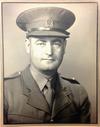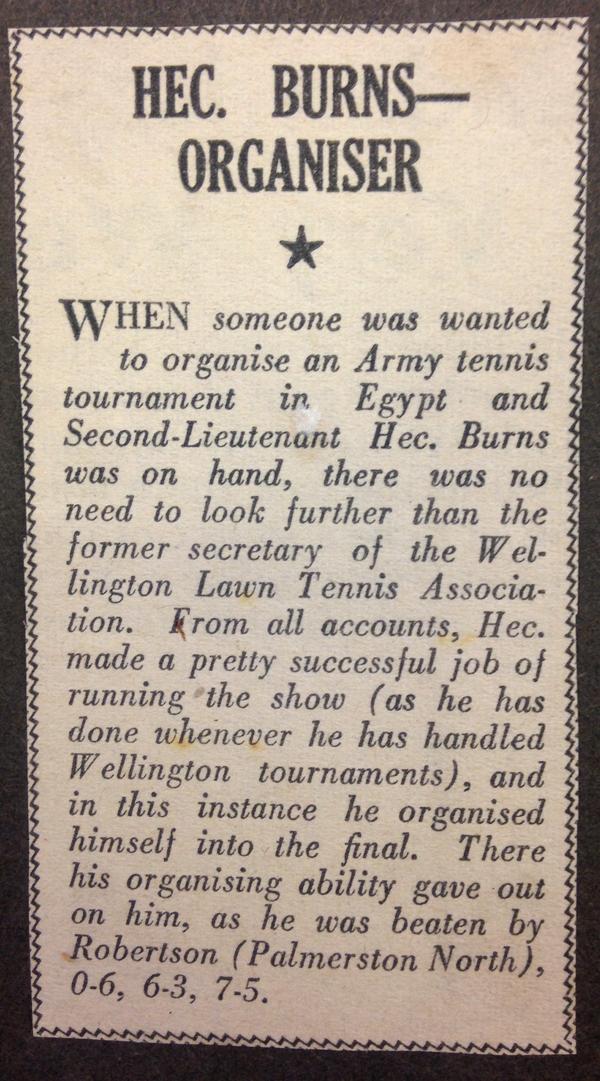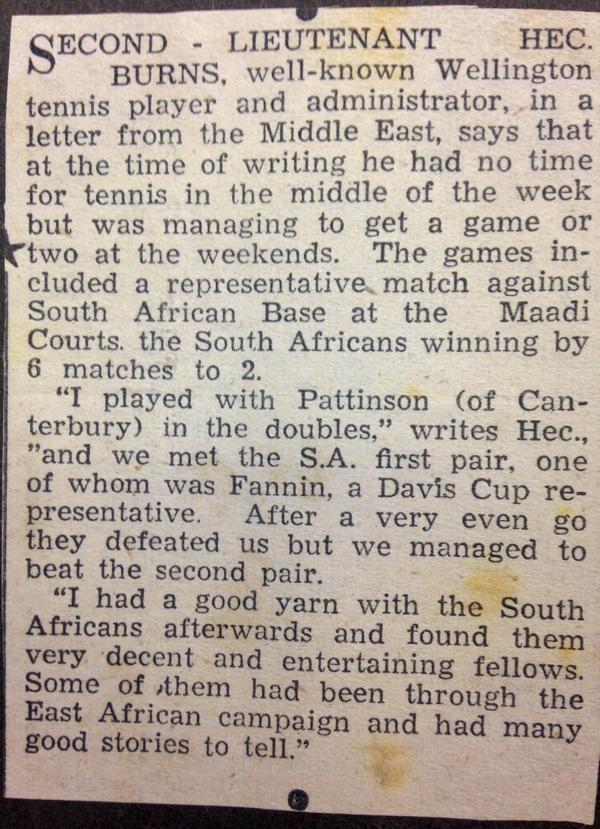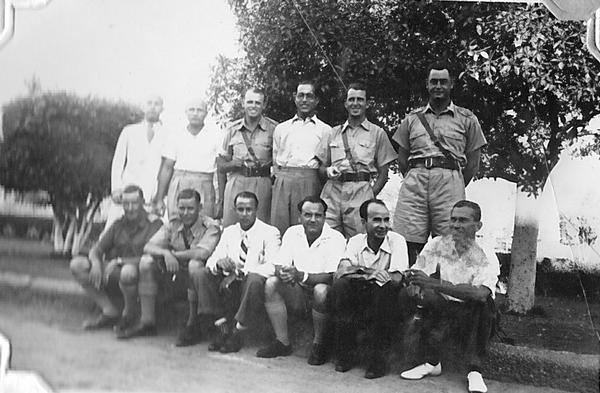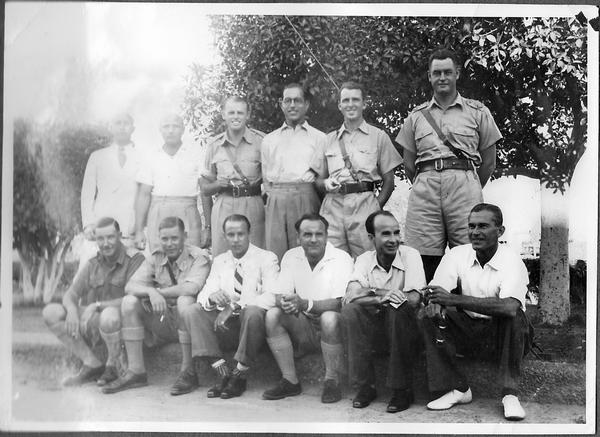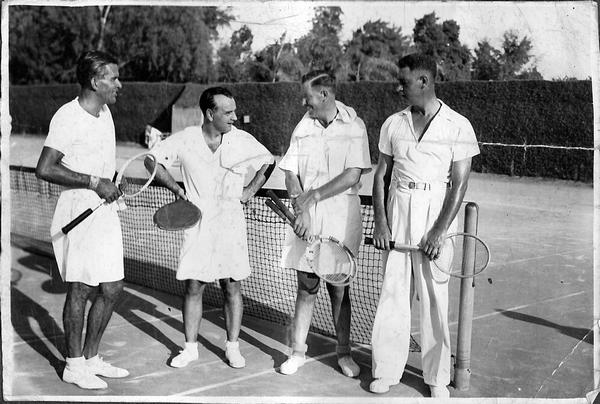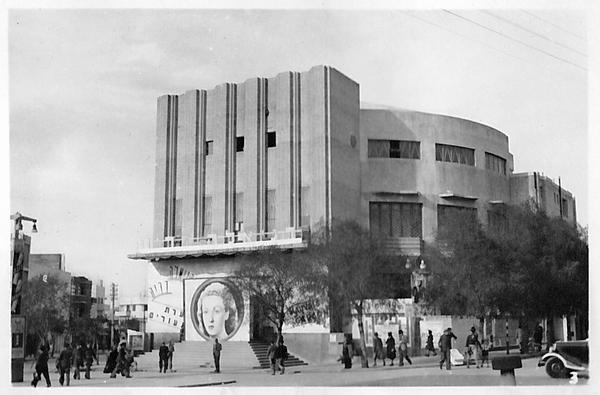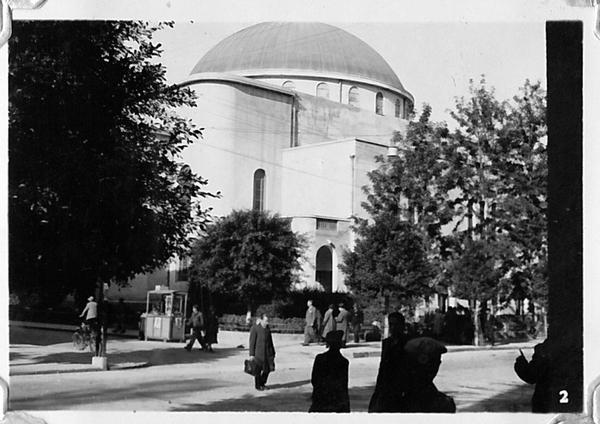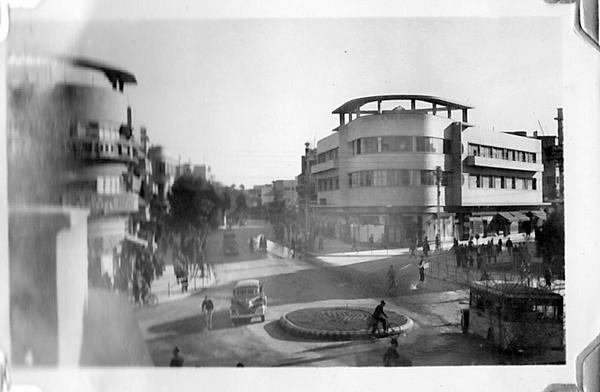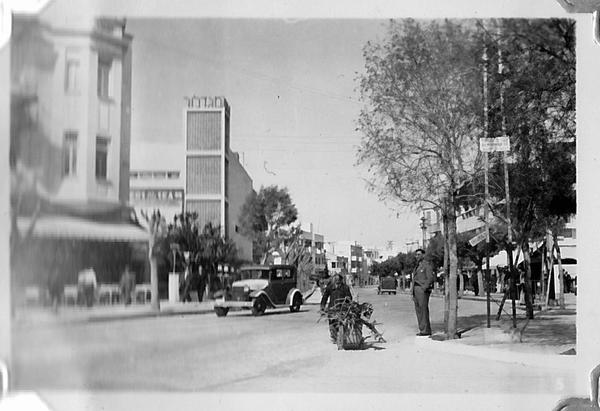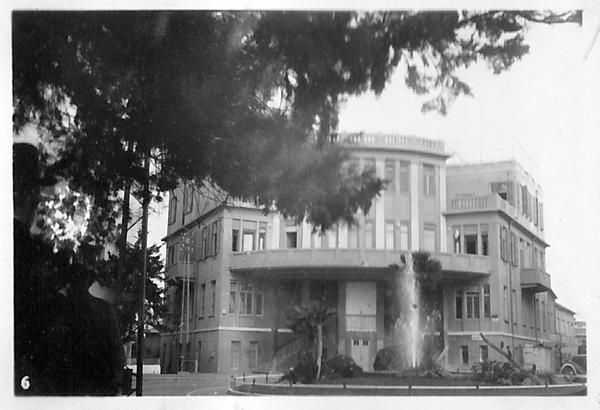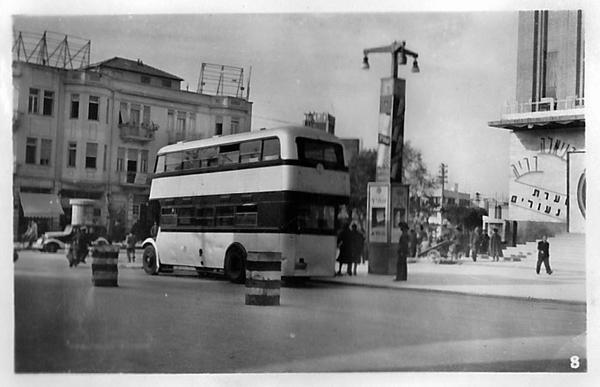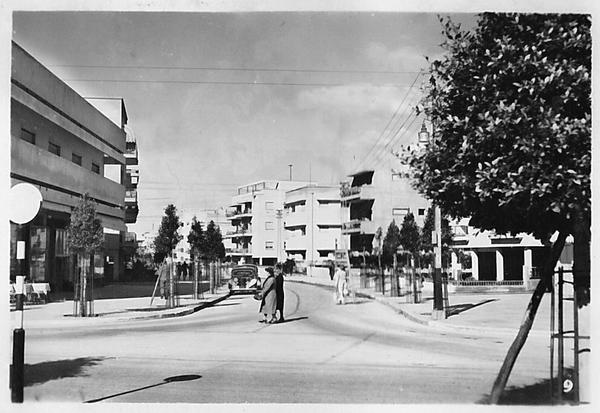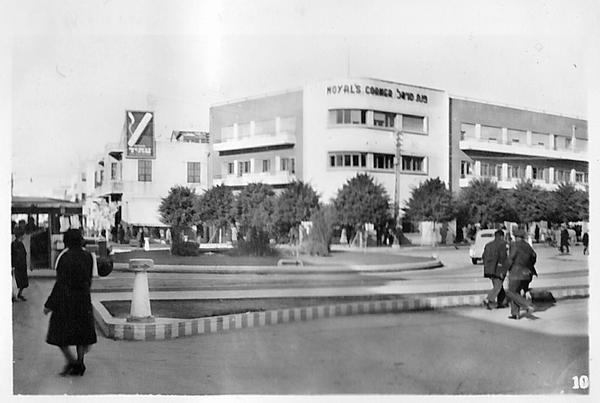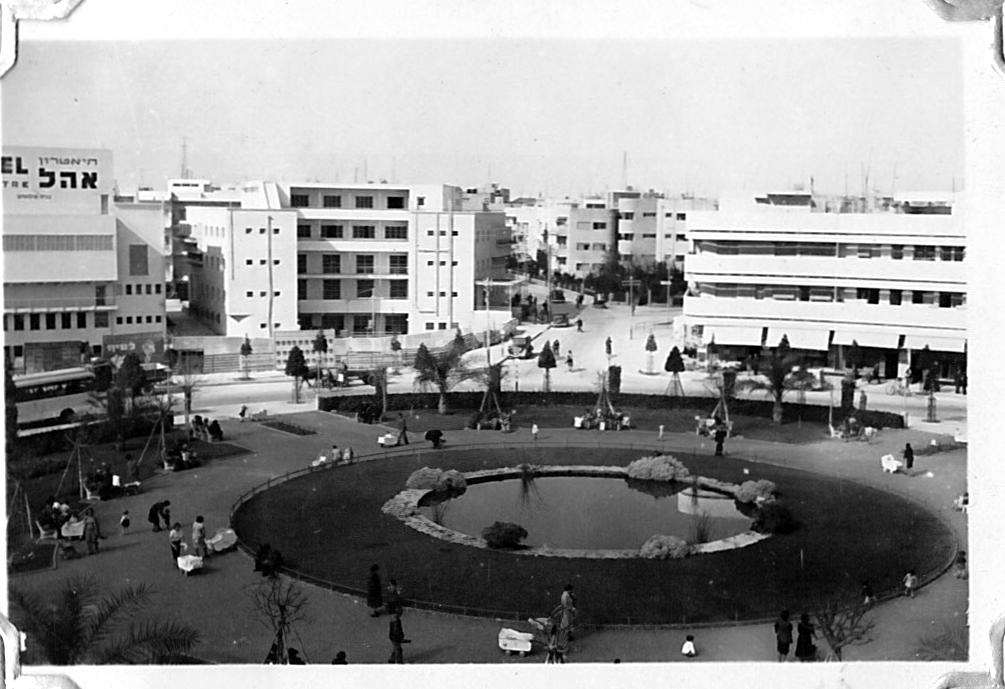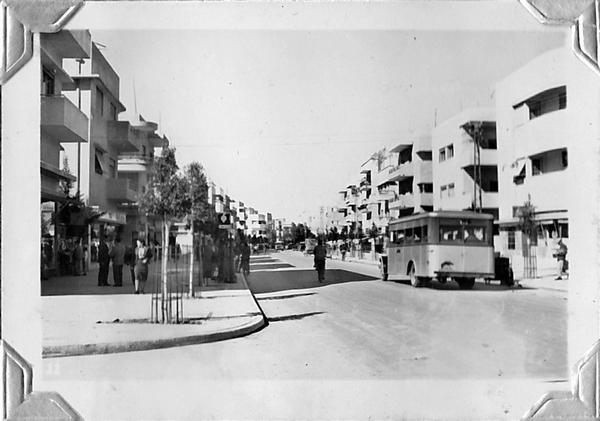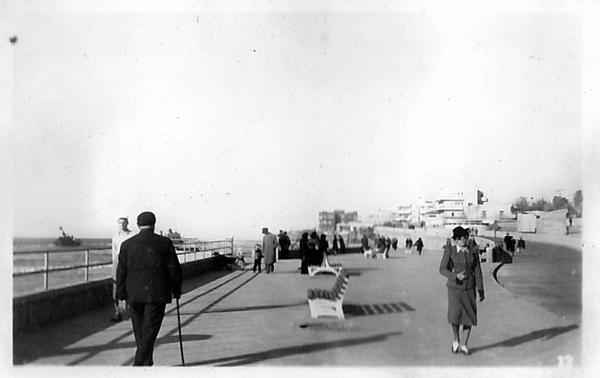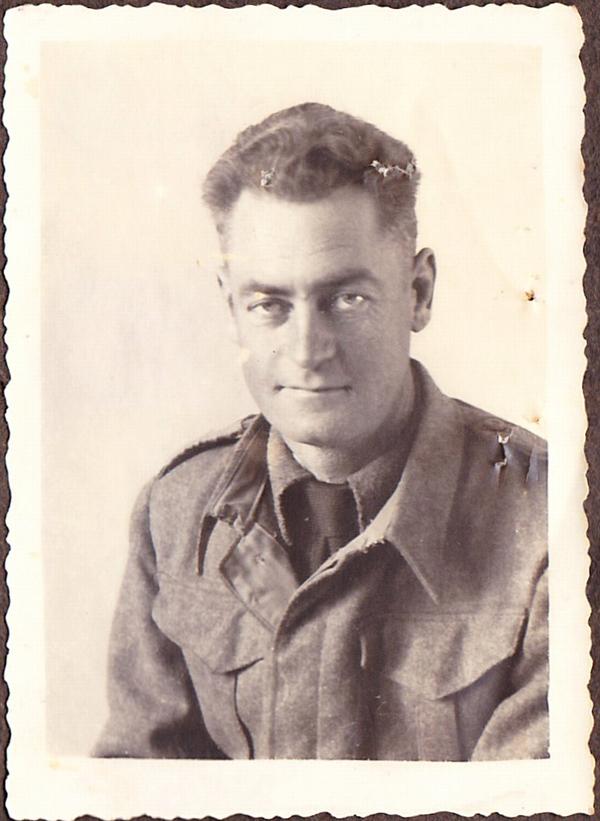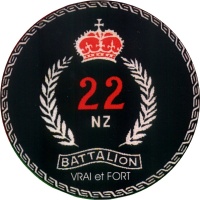
22nd Battalion 2NZEF
"Vrai et Fort"
The Photographs of CPT Hector Nisbet BURNS 30928
Egypt, Syria and life as a POW
Hector Nisbet BURNS (Hec) was a partner in a law practice when war began in late 1939. He decided to enlist but at age 37 was considered too old. But this did not deter him, so on 16 January 1940 Hec fronted up to the recruiting officer
and gave his date of birth as 19 November 1905 (he was actually born in 1901). He trained at Trentham but was held back when the Second Echelon departed for Great Britain in May 1940, to serve as a training officer (2nd Lieutenant) for newer recruits.
He finally departed on 7 April 1941 as part of the 5th reinforcements onboard the Mauritenia, a converted passenger liner. Hec then spent about six months at Maadi Camp in a training role. While here he visited the Pyramids and went on leave to Palestine.
Hec BURNS was posted to the 22nd Battalion on 7 January 1942, joining the Battalion at Kabret on the shore of the Little Bitter Lake, Egypt (part of the Suez Canal). The Battalion War Diary states: "8 January: Reinforcements approximately 200
in number arrived at 0700 hrs." The January War Diary also records all officers attached to the 22nd Battalion - 2nd Lieutenant HN BURNS is listed. Soon the Battalion headed west into the desert, to set up defences south of Tobruk. This did not last long and the
Battalion was soon back in Maadi, before being sent to Syria to guard against a German advance here, but this did not materialise. The Battalion clearly enjoyed its time in Syria but this ended when the Battalion was rushed back to Egypt to defend
the Alamein Line. Here the Battalion suffered its worst day, with most of the Battalion taken prisoner at Ruweisat Ridge on 14-15 July 1942, when the British armour failed to support the attack. Hec BURNS was now a "guest" of Germany for the remainder of
the war.
These photos are from his album and record his time in Maadi and Syria, his tennis prowess, leave in Palestine and his time in German Prisoner of War Camp Oflag V A (a camp for officers in Weinsberg, Germany).
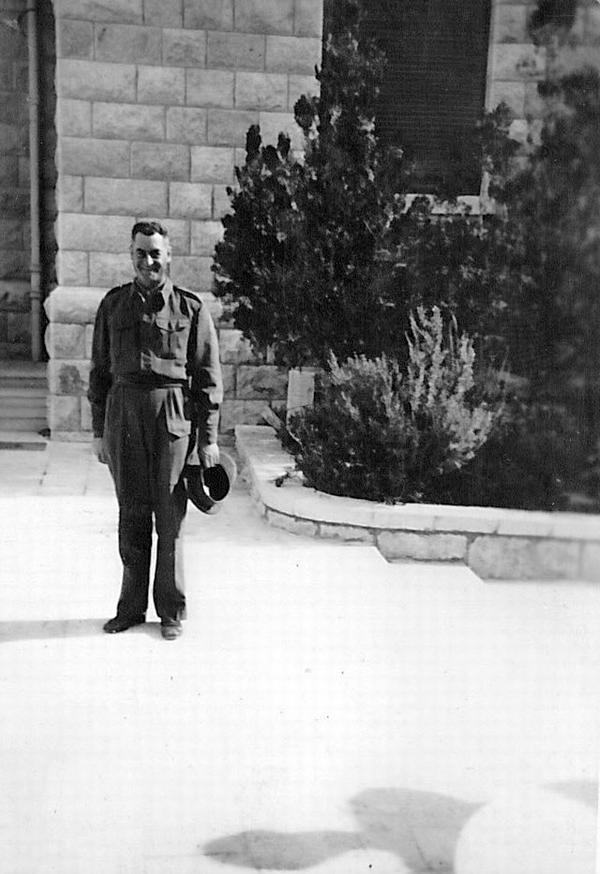
Hec Burns in the Middle East - taken at Nazareth in front of the Church of St. Joseph |
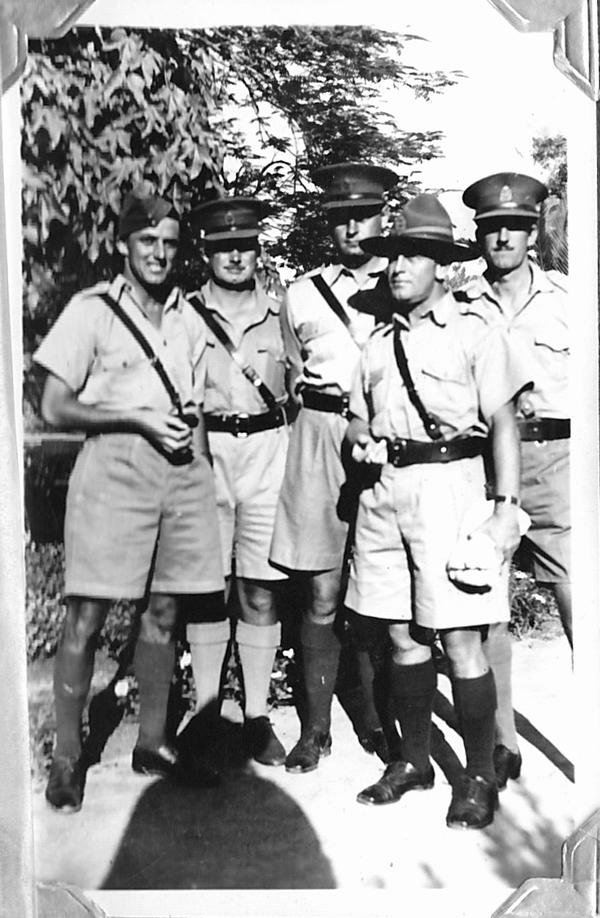
Officer's Club, Maadi
(Click on any photo for the full-sized version) |
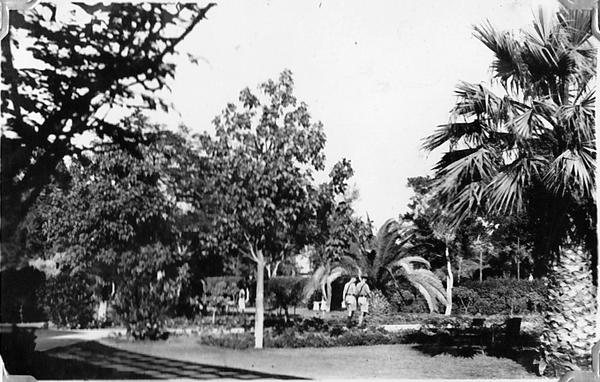
Grounds of the Maadi Officer's Club |
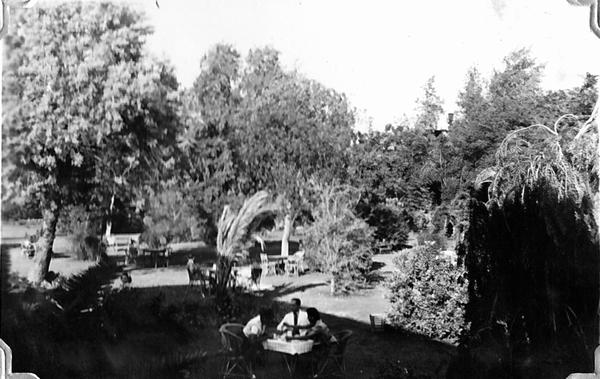 |
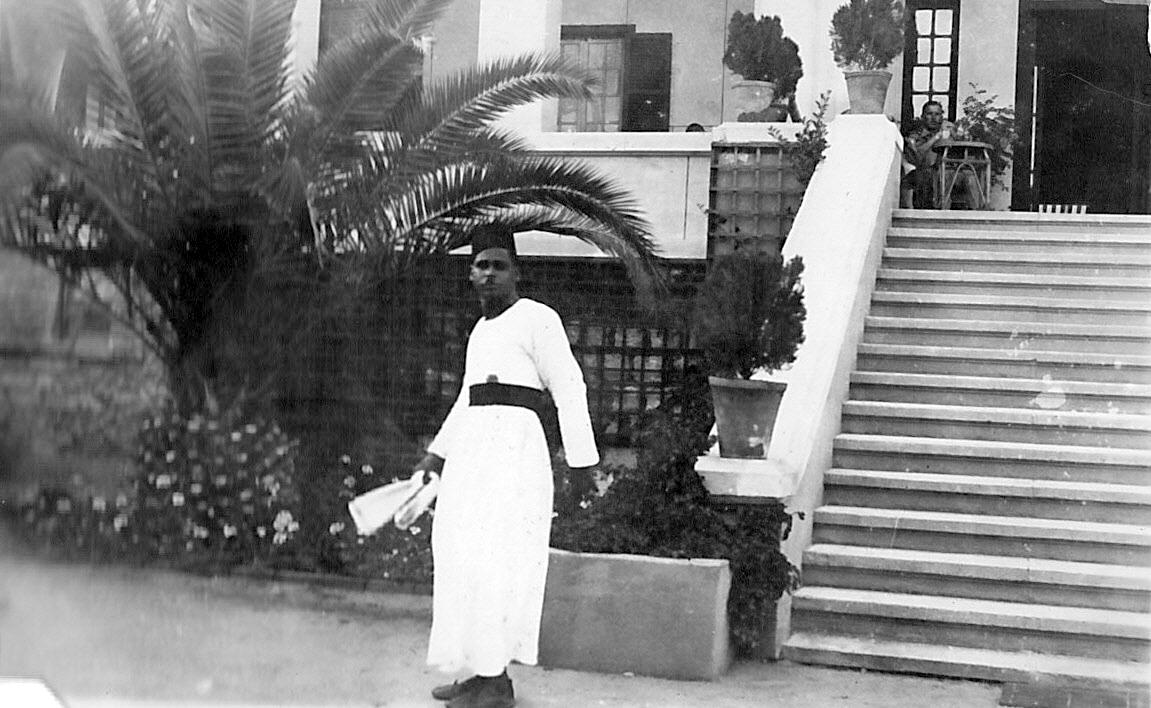
A waiter at the entrance to the Maadi Club |
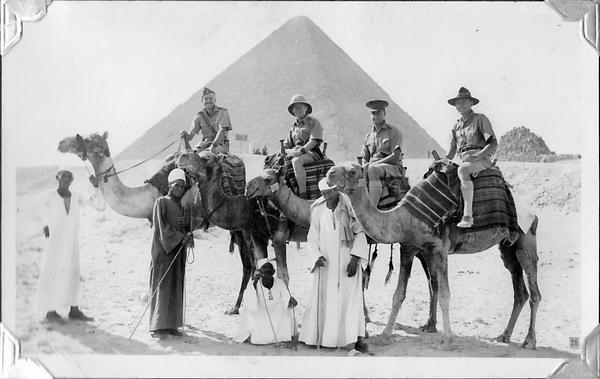
On camels at the Pyramids |
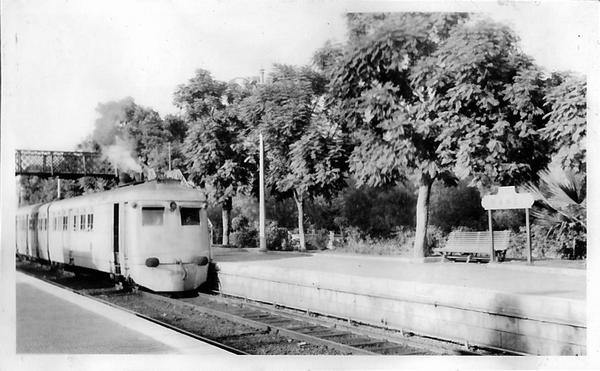
A train at Maadi Station |
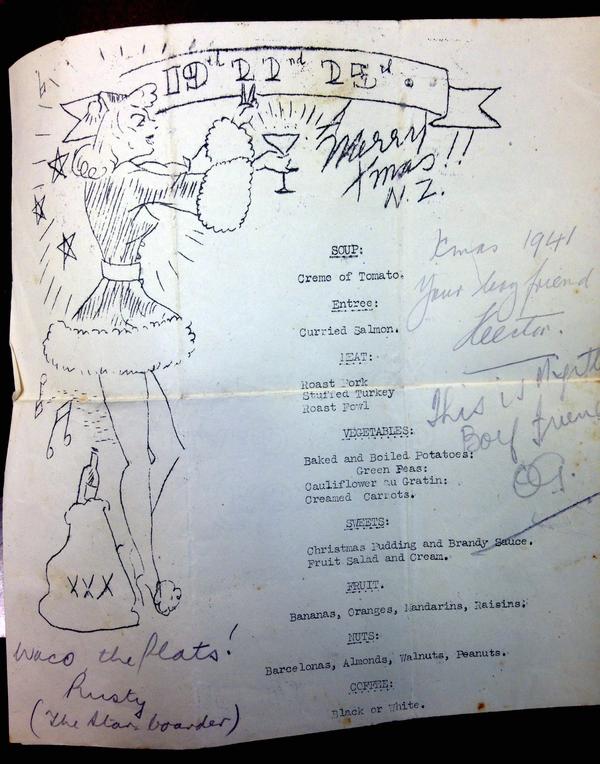
Christmas Dinner Menu - Maadi, 1941 |
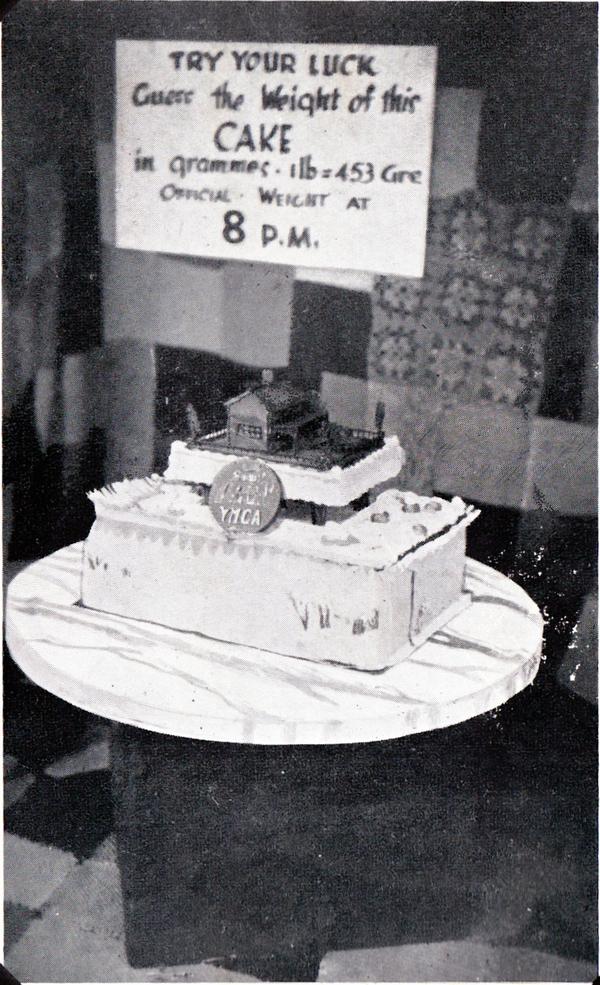
"Guess the weight of the cake" - a YMCA fundraiser. |
Tennis at Maadi
In October 1941 Hec was called on to organise a tennis tournament at Maadi Camp. This he was well qualified to do, having been Secretary of the Wellington Lawn Tennis Association.
A week's Leave in Palestine
In November 1941 Hec had seven days leave and took a tour to Palestine with two friends, including Peter Webster who was later killed in the war. He sent photos from this trip back to his parents. Most of the photos come from photo sets he purchased.
They are identifiable by a small number in the corner - many other men sent the same or similar photos books back home.
Tel Aviv
Jerusalem
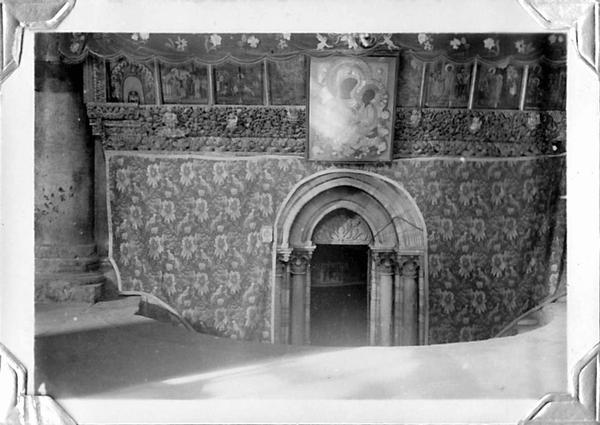
Bethlehem - Entrance to the Grotto od Nativity where Christ was born |
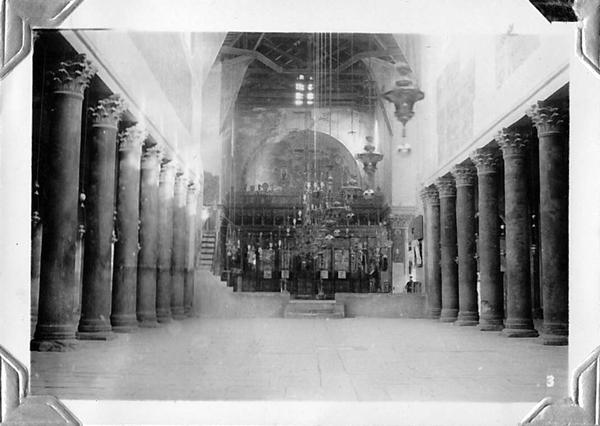
Bethlehem - Interior of the Church of Nativity built over the place where Christ was born. |
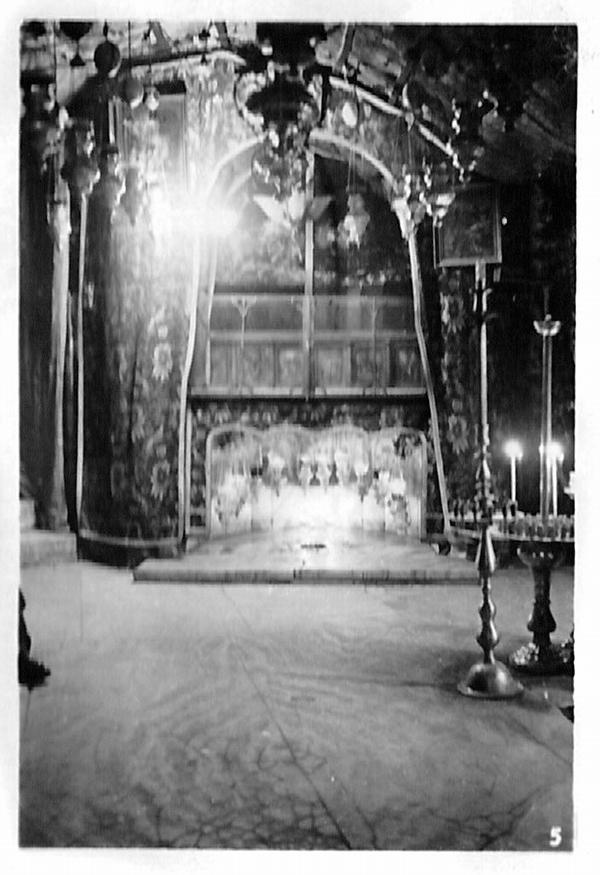 |
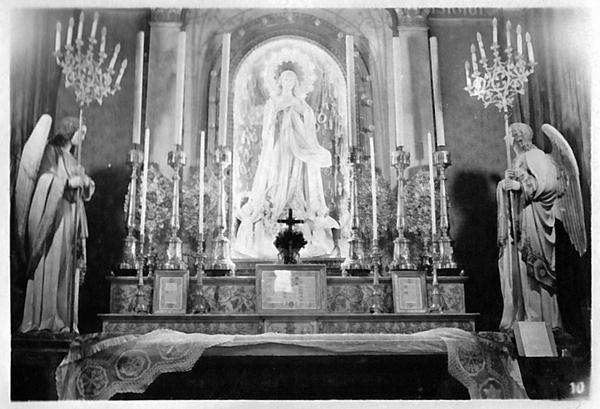 |
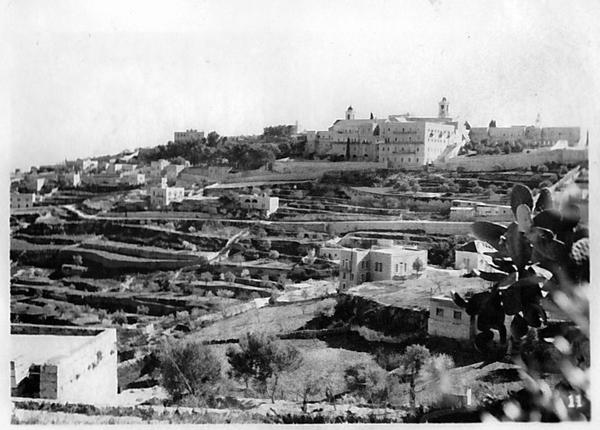 |
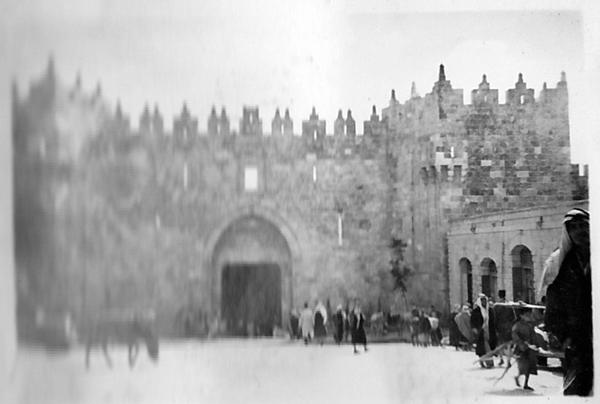
Damascas Gate - Jerusalem |
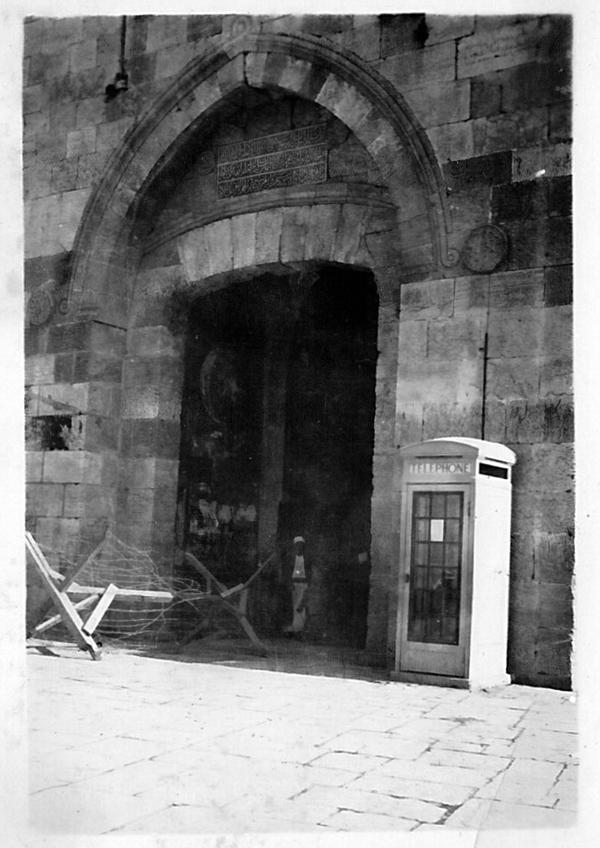
Jaffa Gate - Jerusalem. This is the gate by which Allenby entered Jerusalem during the last war. |
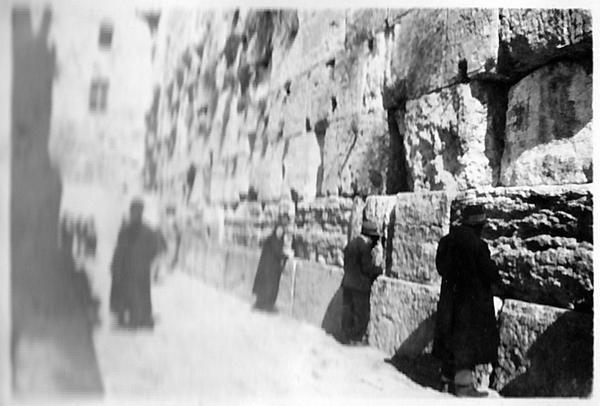
Wailing Wall - Jerusalem |
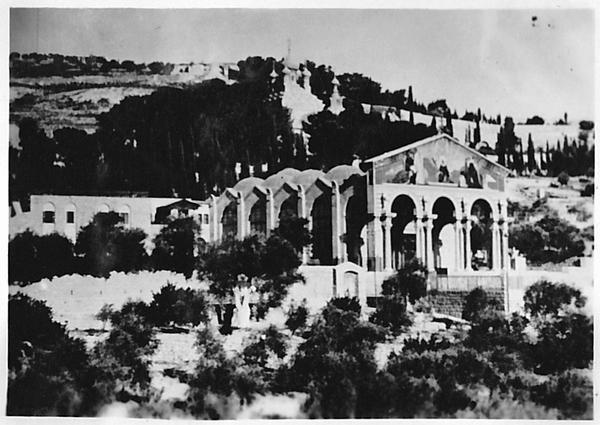
This is where Christ went to pray with the disciples just before the crucifiction - the church is Franciscian. |
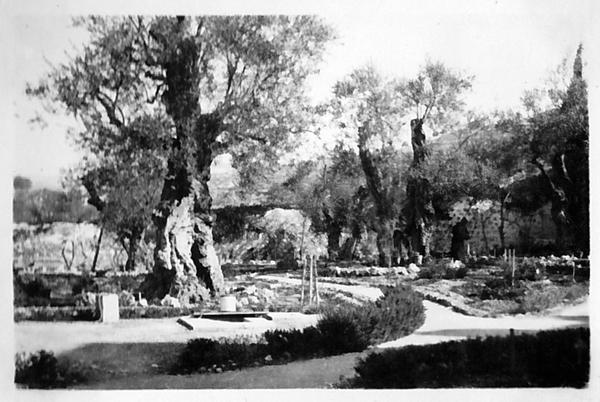
Garden of Gethsemane - Jerusalem. These olive trees are so old that they are said to have existed in Christ's time. |
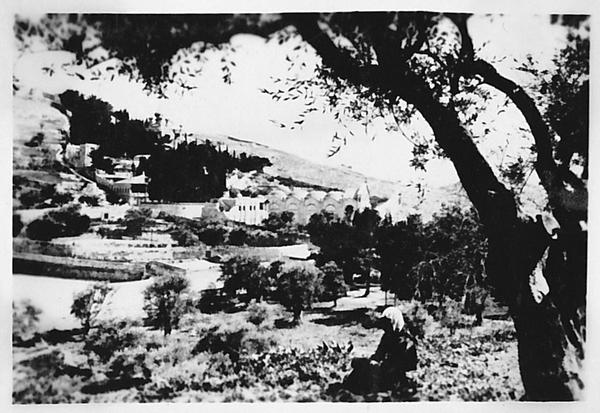
Another view of the gardens. |
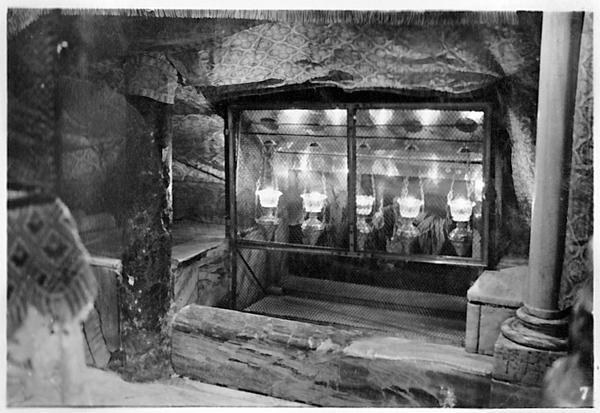
Bethlehem - the Manger |
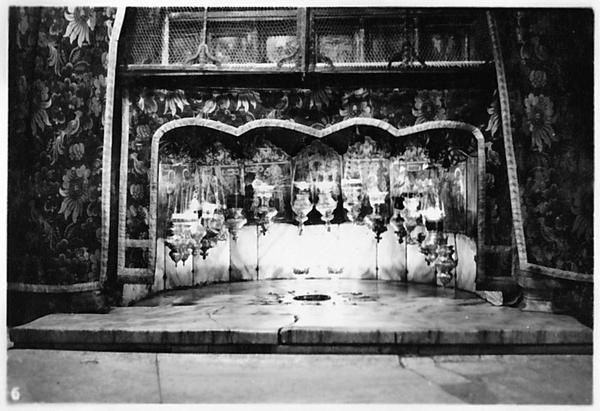
Bethlehem - The place marked by a star is where Christ was born. |
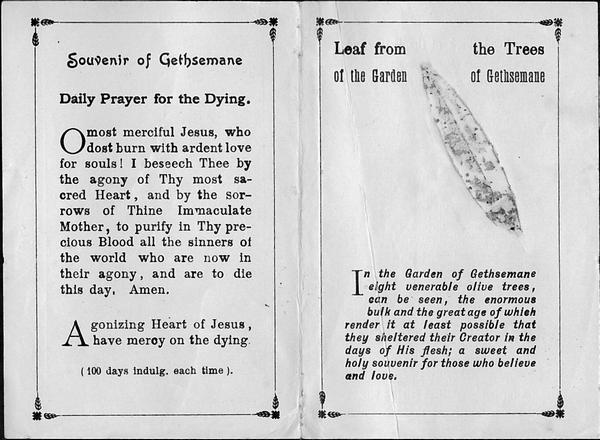 |
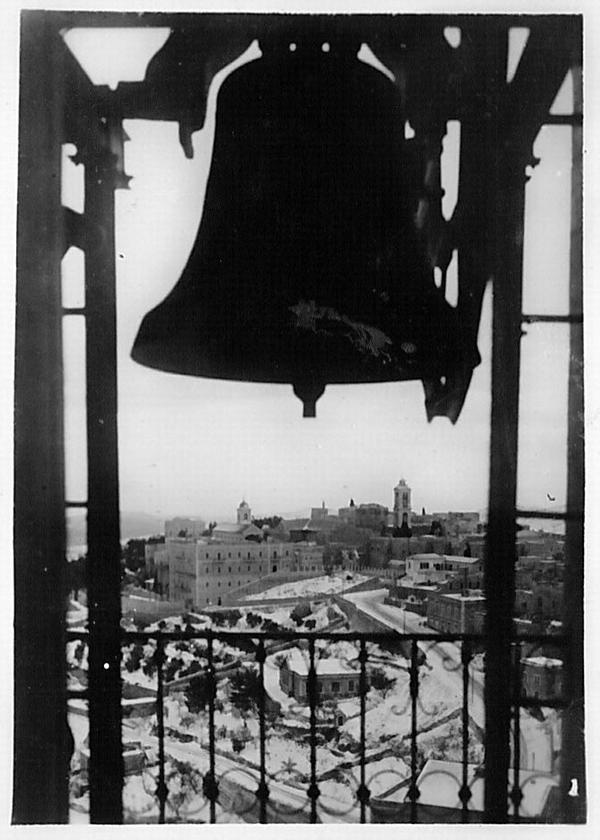
Bethlehem - general view |
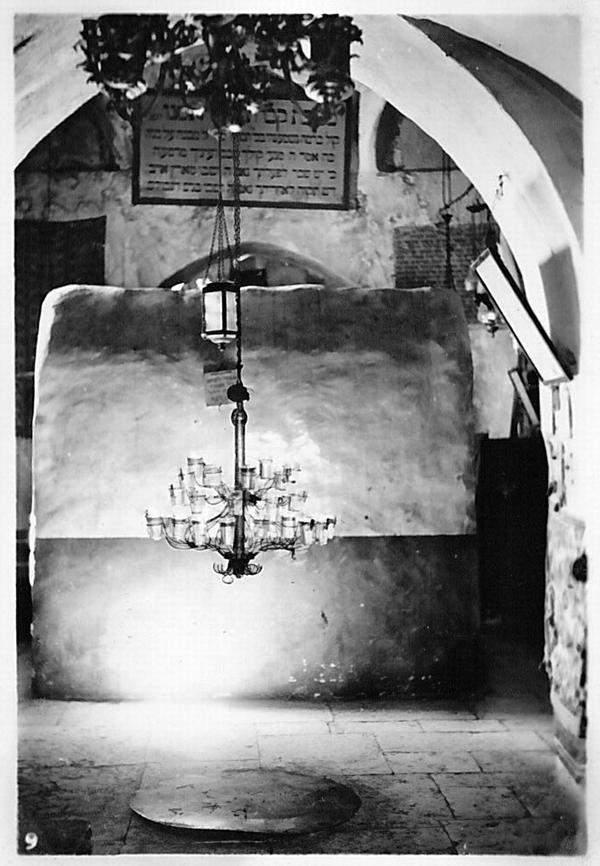
Interior of Rachel's Tomb on the road from Jerusalem to Bethlehem. Rachel was the wife of Jacob. |
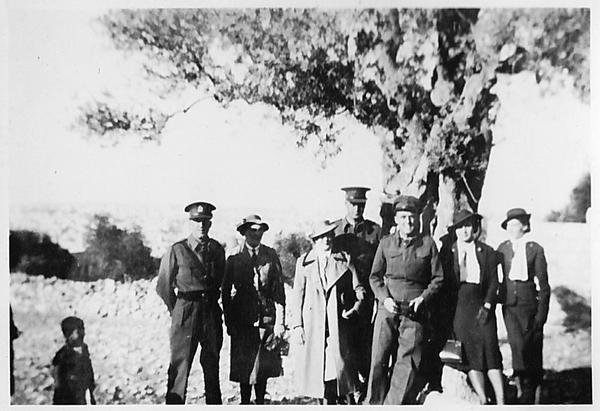
At the top of the Mount of Olives. Members of the touring party. |
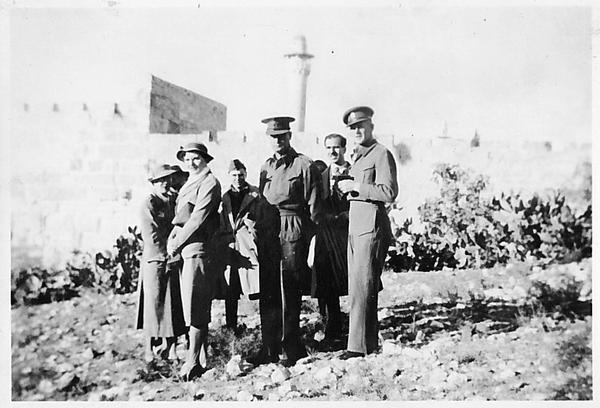
Outside the walls of Jerusalem. |
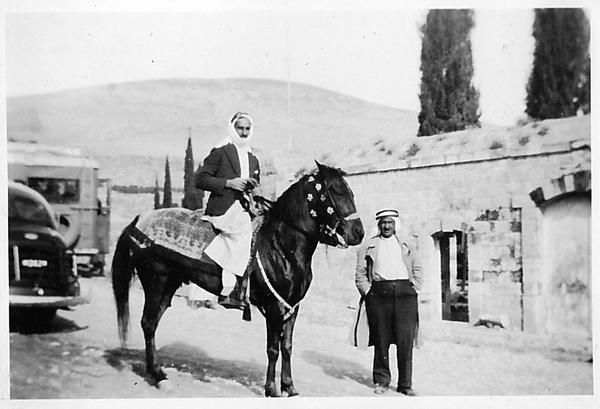
An Arab and his steed. The one standing is the chauffeur |
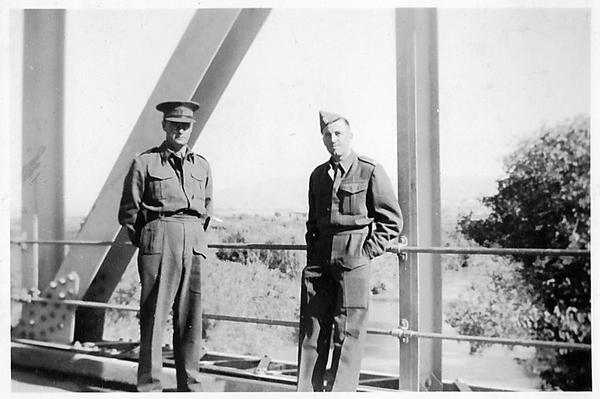
On the Allenby Bridge over the River Jordan. |
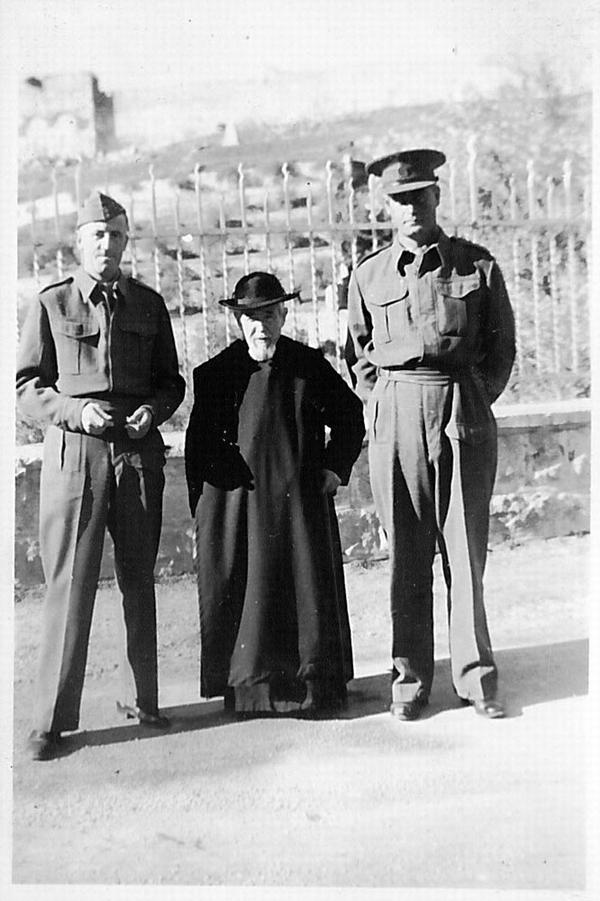
With an old monk. |
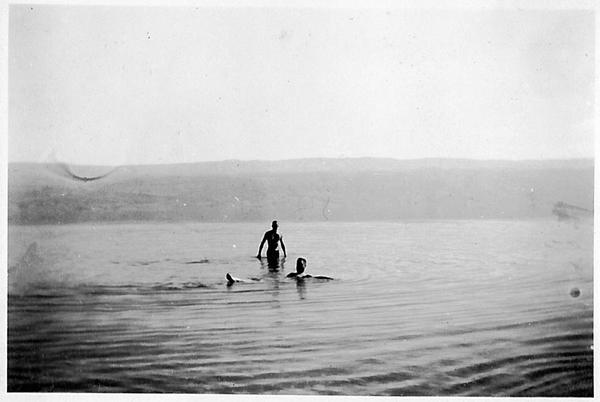
Swimming in the Dead Sea. |
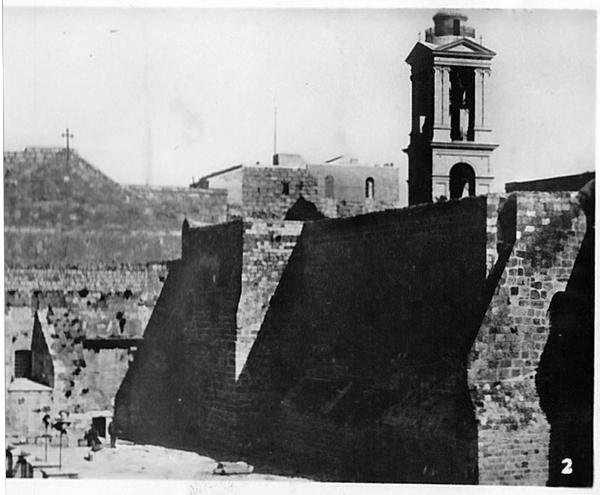 |
 |
War in the Desert
After a brief period of training beside the Suez Canal, practicing in amphibious landings, the Battalion set off west to set up defences south of Tobruk, at El Adem. Here they dug in, laying barbed wire and mine fields. They also undertook extensive salvage parties,
collecting up supplies, field guns and ammunition left behind by the retreating Italian forces. In this regard the 22nd Battalion won the prize for the most salvage collected by the NZ Division. The following photos are probably from this time.
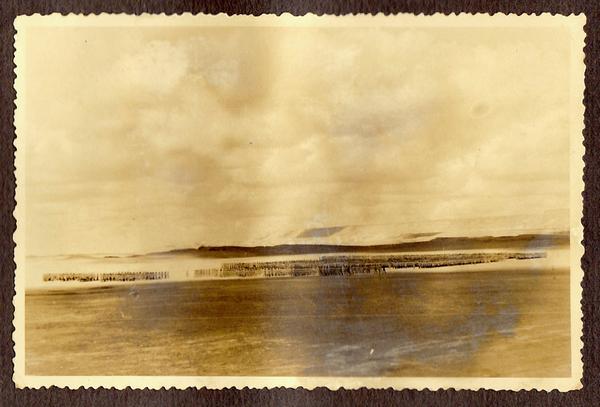
Troops on parade in the desert |
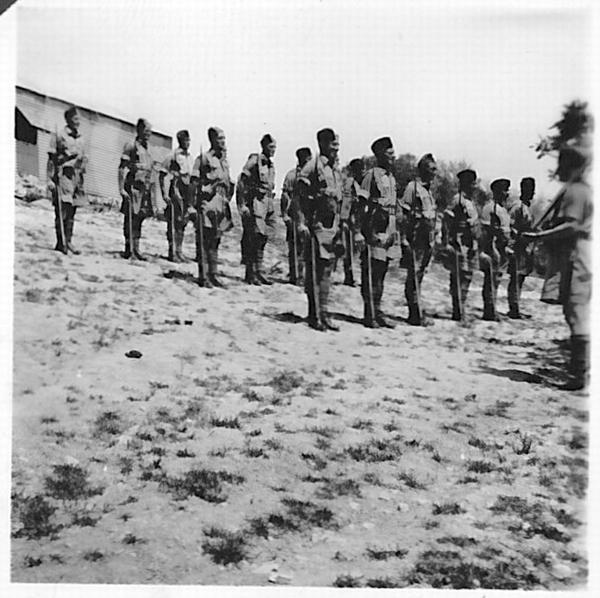 |
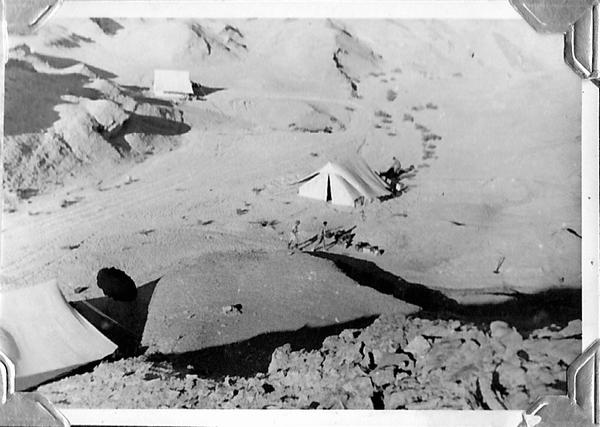
The Desert Camp |
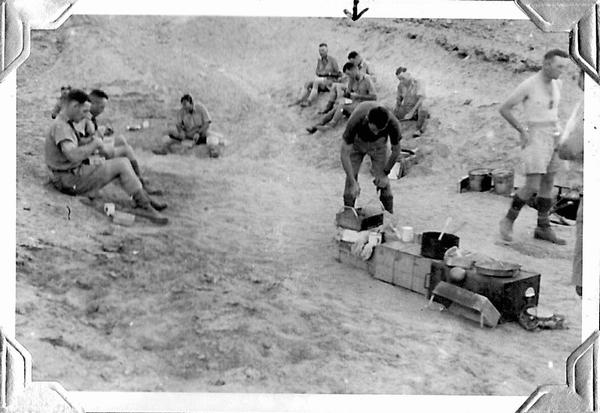
Dinner time at the desert camp |
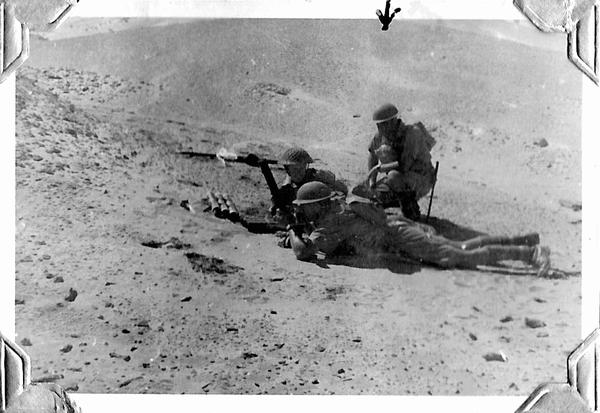
Firing during a tactical exercise |
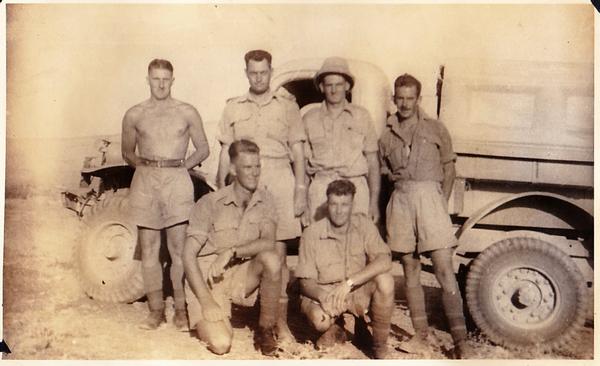
In the desert |
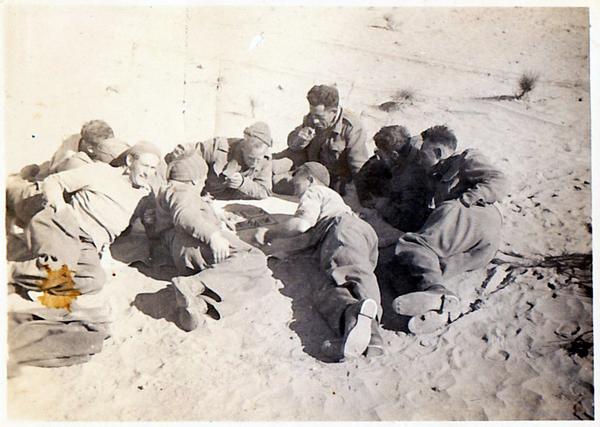
Playing a board game in the desert - probably Ludo. |
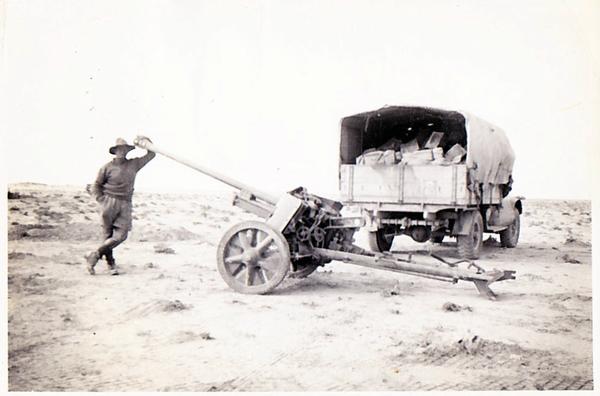
A light Howitzer, possibly Italian. Note the back of the truck is full of scavenged boxes of supplies. |
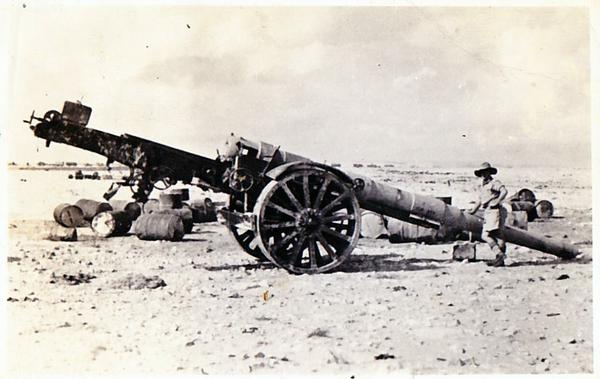
An abandoned large calibre field gun |
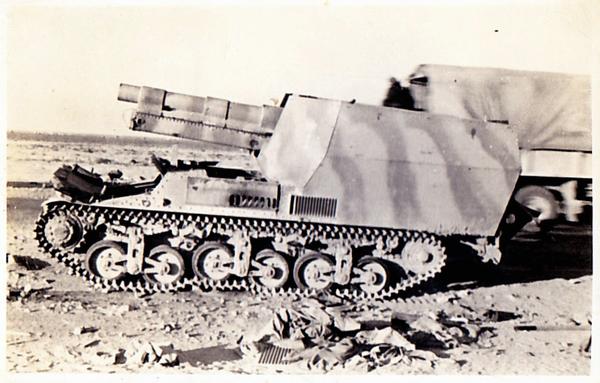
A German self-propelled howitzer (the Lorraine-Schlepper 150mm) |
Prisoners of war
In Hec's collection is a photo that appears to be of a group of prisoners, with one keeping his distance. Also in Hec's collection is a receipt for the delivery of "2 officers 90 O/Rs (other ranks) German and 1 Libyan P.O.W.S" dated 26 March 1942.
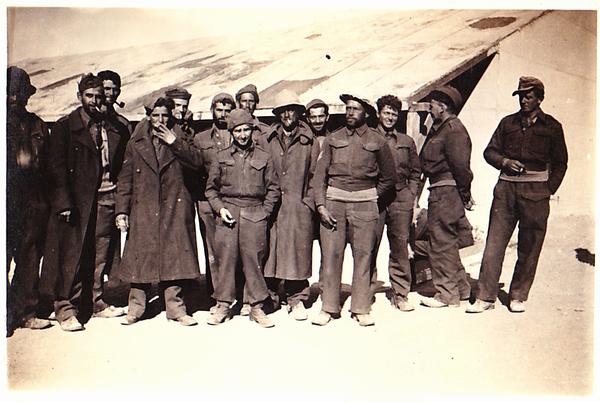
This photo appears to be a group of Italian prisoners, with one German keeping his distance on the right. |
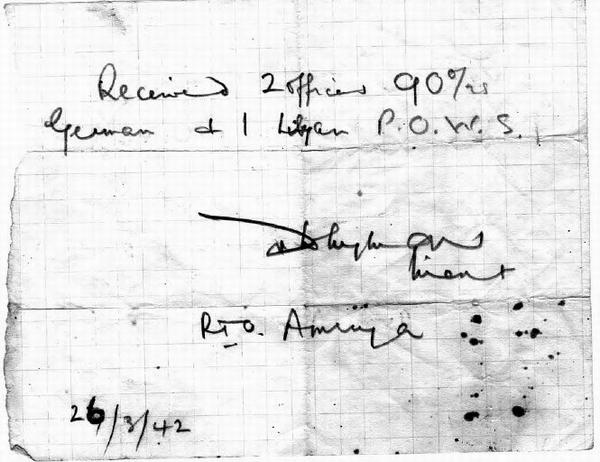
Receipt for the delivery of 93 prisoners. |

Battalion War Diary for 22 March 1942. |

Battalion War Diary for 26 March 1942. |
Interlude in Syria
In early May 1942 the New Zealand Division, 22nd Battalion included, moved east to Syria, to guard against a German invasion from the east. This was a restful time for the Battalion, where they were able to recouperate and train.
They got on well with the local population, the War Diary records the Battalion handing out food and medical support. Hec BURNS, as an officer, took part in ceremonies with the locals. One was recorded in the RSA newspaper.
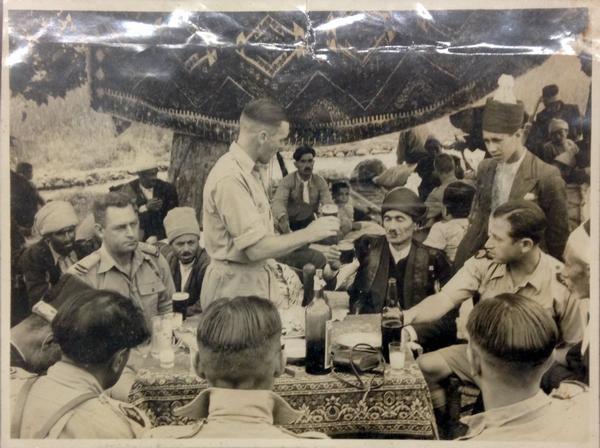
"Major Hanlon is proposing the toast of the native Kurdish Chief - Syria 1942. HN Burns is the man behind Major Hanlon. |
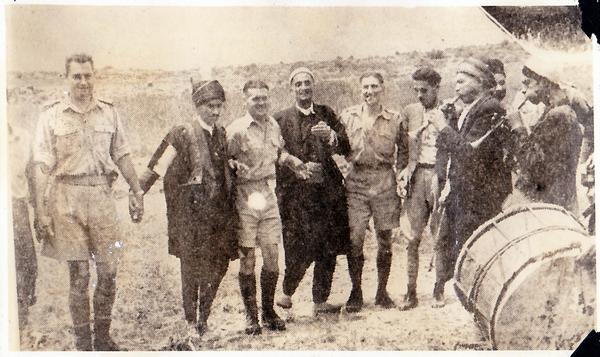 |
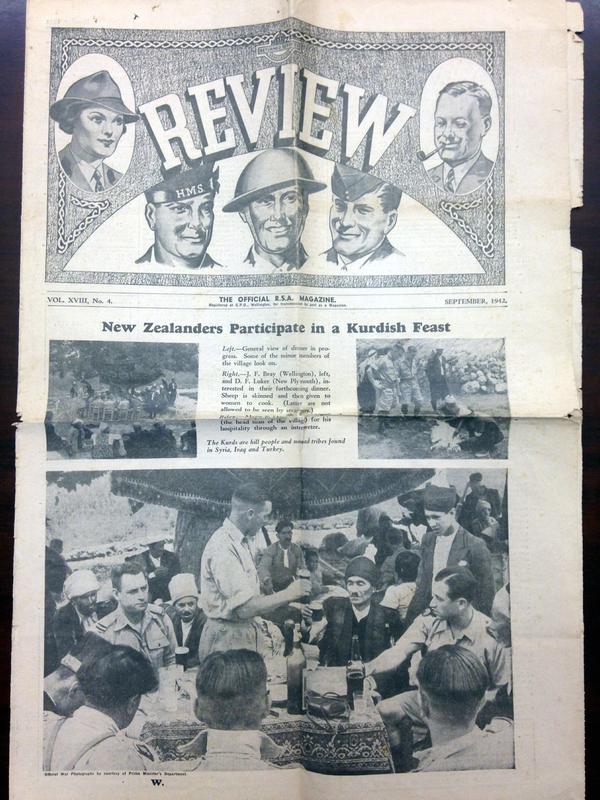
RSA Review, September 1942 |
Into Captivity
On the night of 15-16 July 1942 the 22nd Battalion was part of the attack on Ruweisat Ridge in Egypt. It proved to be a disaster, with most of the Battalion being captured, despite being the only Battalion to gain the objective and to hold the ridge until daybreak.
Hec BURNS was now a prisoner of war. He kept a diary of his first few days, writing in his Paybook.
| Wednesday 15/7/42 | Captured. Marched 10 miles in heat. No food. Little water. Trucks to Daaba. Treated not unkindly by Germans. Night in prison camp Daaba. 1 packet biscuits, water. Searched. | |
| Thursday 16/7/42 | Trucks to Mersah Matruh. Uncomfortable. Particulars taken. Water. Left late afternoon. Night at (illegible) . Blankets and shorts found on truck. 1 tin bully between 2. | |
| Friday 17/7/42 | Continued to Tobruck via Solum. Bath at Solum. Dust and flies (illegible) (illegible ) at Tobruck. Searched. (illegible) obtained.. Night Tobruck. | |
| Saturday 18/7/42 | Good breakfast. Proceeded to Barce over 200m by truck. Long uncomfortable journey. Two large biscuits. At Barce, blankets and beds in transit prison camp. | |
| Sunday 19/7/42 | Remained at Barce. Disinfected. Filled in forms. Paid 50 lira. (Illegible) .Food, bread vegetable soup, cheese, tin bully. Cigarettes. Sanitary conditions (illegible) Church service. Water plentiful. | |
| Monday 20/7/42 | Barce to Bengazi. Prison camp very (illegible) . Daily (illegible) of food. Morning one half pint of coffee – midday I tin bully, one small loaf (illegible) bread. | |
| Tuesday 21/7/42 | At Bengazi prison camp all day. | |
| Wednesday 22/7/42 | Truck to wharf. Placed on ship. In hold very cramped. Issued 2 tins bully and 4 biscuits for 2 days. Much seasickness and (illegible). Slept on deck. Very cold. Sanitary conditions terrible. No organisation. Escorted by 4 destroyers and planes. | |
| Thursday 23/7/42 | On ship. Sea calmer. Spent day on deck but very hot at midday. Stench from latrines. Food insufficient. Over 3000 men on board very cramped. Men scrambling for scraps from kitchen. Sighted coast of Greece. Entered Taranto Harbour. Night on ship. | |
| Saturday 24/7/42 | Taken ashore by launch. Issued 1 tin bully2 biscuits. Found food on launch. Train to Bari prison camp. Conditions good. | |
| Sunday 26/7/42 | At Bari. Disinfected. Searched. Food issue good. Accommodation good. | |
| Monday 27/7/42 | At Bari. Camp under better organisation.
|
He remained in Italy for a few months, until October 1942, when he was transferred to Germany, first to Stalag VIIA, which was at Freisling, near Munich, then on 13 December 1942 to Oflag V A which was at Weinsburg, in South-Western Germany
near the French Border. He remained in Offlag VA as POW 2277/18 until it was liberated by American troops in early May 1945.
Oflag V A was better run than many German camps. It did not suffer the severe overcrowding caused by the capitulation of Italy in July 1943 and the removal of prisoners to Germany. Its population remained at about 1130, of whom about 140 were
officers and 10 other ranks from New Zealand.
"The camp population at Oflag VA at Weinsberg had been of a higher density than that usual for officer prisoners. As in most camps overcrowding was felt less in summer, when much time could be spent in the open air. In the early part of 1944 the Germans
had carried out a number of improvements. The water supply had been increased so that hot showers were available weekly, sanitation was better, the lighting had been made somewhat stronger, and facilities for sports were greatly increased. Parties of
120 prisoners at a time were allowed the use of a fine sports field amid the woods about half an hour's walk from the camp; and a generous supply of sports material from the World Alliance of YMCAs made it possible to use every yard of ground inside the
small barbed-wire enclosure of the camp. Supplies of books and stationery from the same source had enabled the organisation of a wide variety of educational courses, and by early June more than 200 had applied to sit for recognised examinations. While
many of the improvements in the camp amenities had been made possible by generous material aid from Allied sources, the appointment of a new German camp officer had resulted in much more reasonable relations with the German authorities and, in the
opinion of the Swiss delegate, had caused the whole atmosphere to change for the better."
A matter which gave the prisoners in Oflag VA considerable apprehension, and about which it took a long time to persuade the Germans to take action, was the provision of adequate air-raid shelters. The trenches were inadequate in design to afford proper
protection. There were in the immediate neighbourhood a factory for making aircraft wings and another for machine-gun parts, the necessity for protecting the camp from air raids was a real one. In 1944 the trenches were improved, and during a raid prisoners
could use them or remain inside their barracks, whichever they preferred.
From: "Prisoners of War" W. Mason. Historical Publications Branch, 1954, Wellington. Part of: The Official History of New Zealand in the Second World War 1939–1945
|
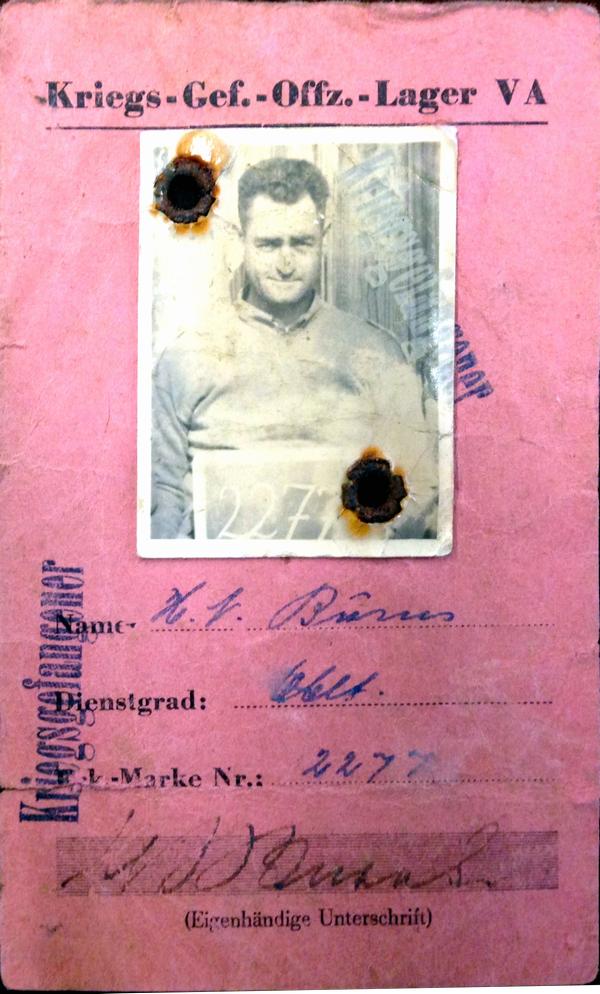 |
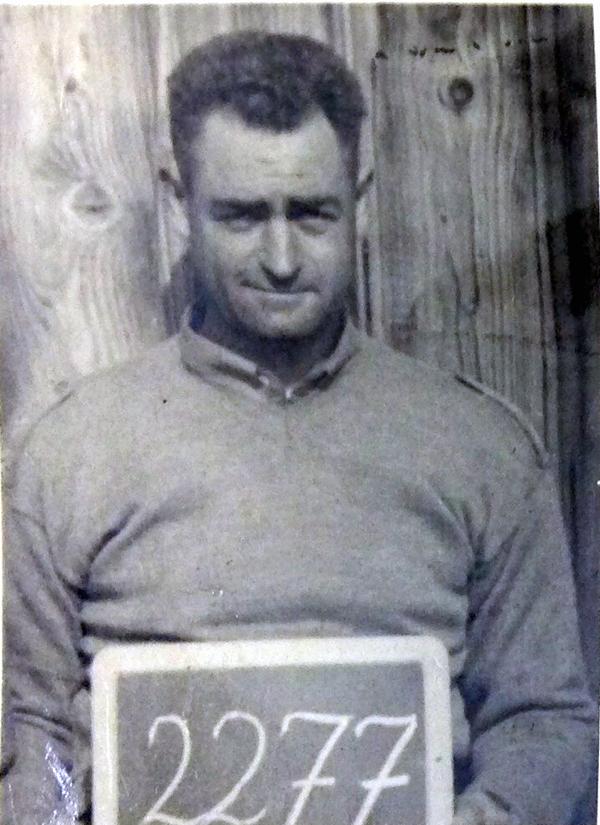
This is the identity card provided to HN Burns at Oflag VA, Germany prisoner of war camp. |
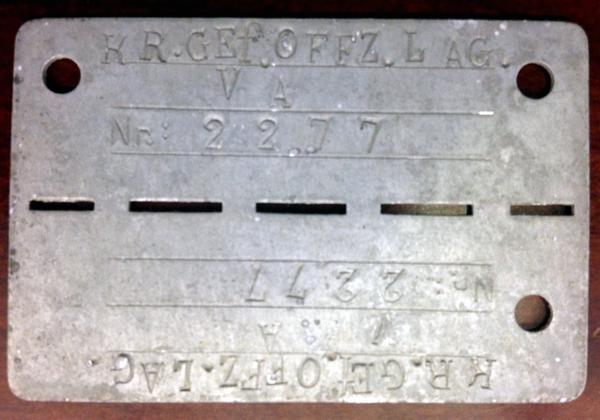
Hec Burns' POW identity tag |
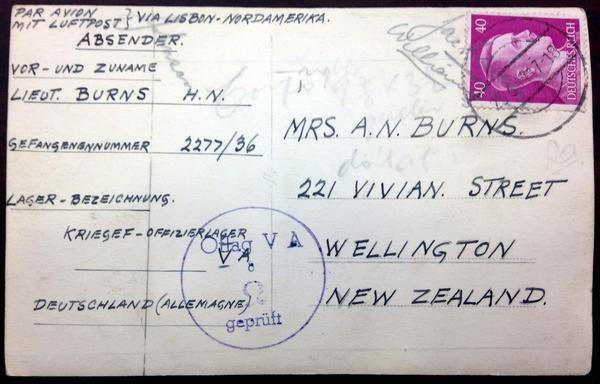
Postcard to his mother showing his location at Oflag V A |
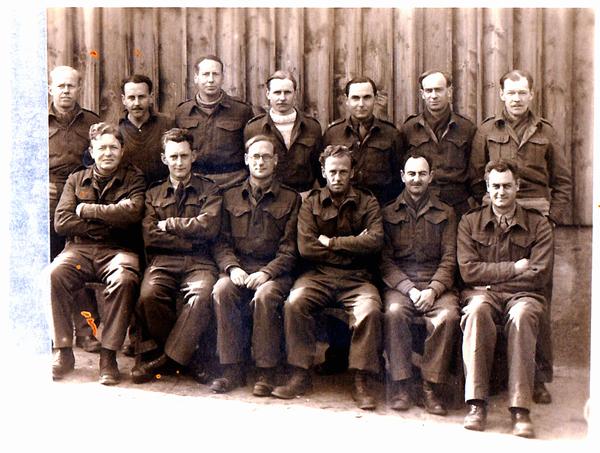
"NZ Prisoners of War in Camp Oflag VA Germany. Capt. H.N. Burns on right of front row." |
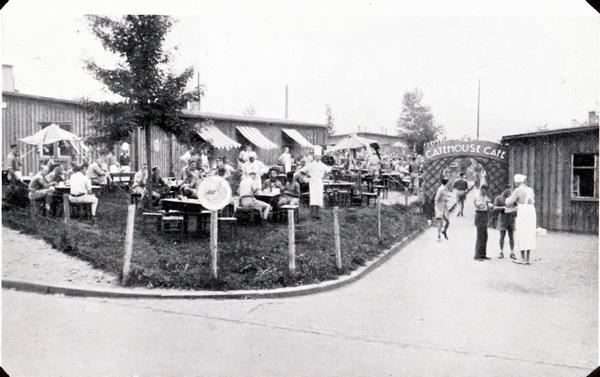
The Gatehouse Cafe in Oflag V A |
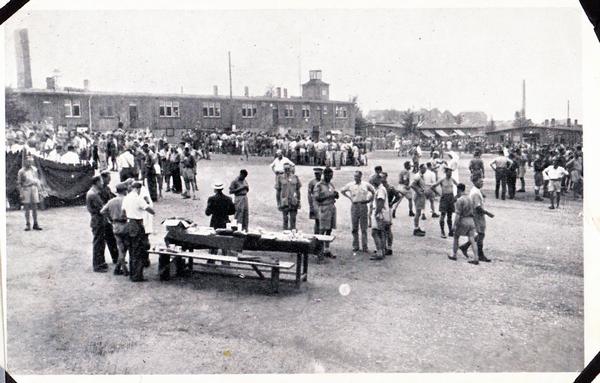
A view of Oflag V A looking across to the Gatehoue Cafe. The packages on the table in front could be Red Cross parcels. |
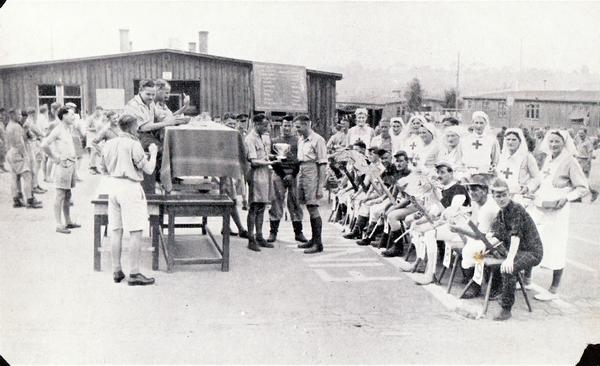 Sports Trophy. The line of competitors sitting on chairs numbered 1 to 9 suggest a "wooden horse race". Sports Trophy. The line of competitors sitting on chairs numbered 1 to 9 suggest a "wooden horse race". |
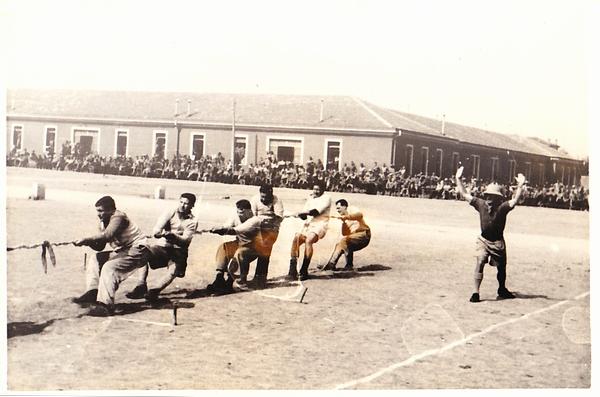
Tug-of-war |
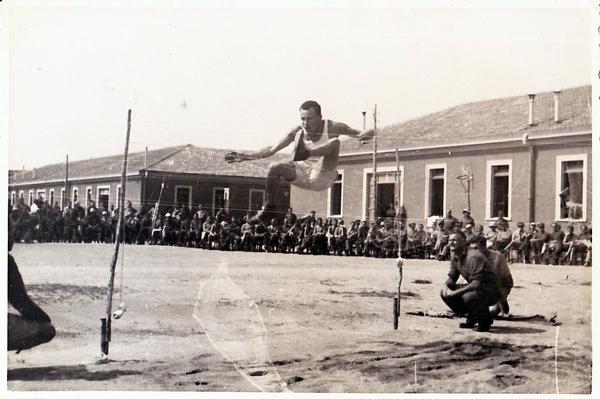 High jump - or maybe long jump. High jump - or maybe long jump. |
Liberation and return to New Zealand
Offlag V A was liberated by American troops in early May 1945, and by 10 May 1945 Hec was recorded as being “safe in the UK.” He spent until 12 June 1945 convalescing in a military hospital in Kent, and then travelled around the UK on leave.
He embarked for NZ on 8 August 1945, and arrived back in NZ on 6 September 1945. His total overseas service was 4 years and 5 months. While in the POW camp, on 17 February 1944, he was promoted from 2nd Lieutenant to Captain. He was posted to
the Reserve of Officers, Supplementary List, on 23 January 1946, and to the Retired List on 31 January 1951.
Return to photograph Page
Last updated: 12 March 2024

